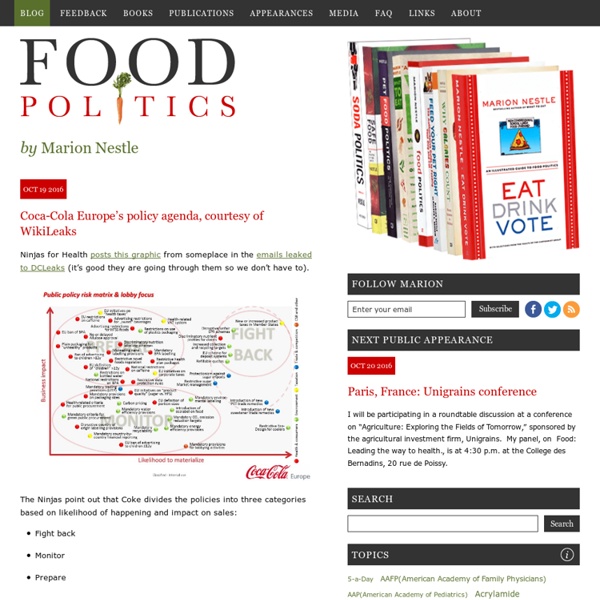



What Should We Know About Foreign Genes In Our Food? Bacteria on bean leaf. In a recent email exchange about the merits of mandatory “GMO labeling,” I was asked this question: “Why shouldn’t we be able to know what foreign genes are in our food?” It seems like a reasonable question to most people. After all, we are the customers; don’t we have a right to know what we want to know? Yale Environment 360: Opinion, Analysis, Reporting & Debate Food Safety - The Science Introduction and Overview It is well-recognized that absolute safety is not an achievable goal in any human endeavor, and this reality is relevant to food and feed safety. The safe use of food or feed has typically been established either through experience, based on its common use, or in more recent times by application of generally recognized scientific assessment measures.
Environmental Health News: Front Page Evidence Stacking Up Against Biotechnology Critics Calestous Juma By Calestous Juma Critics of agricultural biotechnology have long maintained that the technology is unsuitable for small-scale farmers and harmful to the environment. But according to newly-released adoption rates, evidence is pointing in the opposite direction. In its latest report, Global Status of Commercialized Biotech/GM Crops: 2011, the International Service for the Acquisition of Agri-biotech Applications (ISAAA) shows that biotechnology crops now cover 160 million hectares worldwide.
EMagazine.com Executive Summary: Global Status of Commercialized Biotech/GM Crops: 2011 - ISAAA Brief 43-2011 Introduction This Executive Summary focuses on the 2011 biotech crop highlights, which are presented and discussed in detail in ISAAA Brief 43, Global Status of Commercialized Biotech/GM Crops: 2011. Biotech crops reached 160 million hectares, up 12 million hectares on 8% growth, from 2010, as the global population reached a historical milestone of 7 billion on 31 October 2011 Green News and Opinion on The Huffington Post Debate on GMOs Health Risks after Statistical Findings in Regulatory Tests Int J Biol Sci 2010; 6(6):590-598. doi:10.7150/ijbs.6.590 Communication Joël Spiroux de Vendômois1, Dominique Cellier1,2, Christian Vélot1,3, Emilie Clair1,4, Robin Mesnage1,4, Gilles-Eric Séralini1,4 1. CRIIGEN, 40 rue Monceau, 75008 Paris France2.
Blog sobre medio ambiente, ecología y cambio climático. Monsanto's GMO Corn Linked To Organ Failure, Study Reveals In a study released by the International Journal of Biological Sciences, analyzing the effects of genetically modified foods on mammalian health, researchers found that agricultural giant Monsanto’s GM corn is linked to organ damage in rats. According to the study, which was summarized by Rady Ananda at Food Freedom, “Three varieties of Monsanto’s GM corn - Mon 863, insecticide-producing Mon 810, and Roundup® herbicide-absorbing NK 603 - were approved for consumption by US, European and several other national food safety authorities.” Monsanto gathered its own crude statistical data after conducting a 90-day study, even though chronic problems can rarely be found after 90 days, and concluded that the corn was safe for consumption. The stamp of approval may have been premature, however.
PRETOMA Genetic Engineering of Food and the Failure of Science – Part 2 Abstract Factors in the failure of the scientific community to properly oversee agricultural transgenics are presented. The large-scale restructuring of university science programs in the past 25 years from a model based on non-proprietary science for the ‘public good’ to the ‘academic capitalism’ model based on the ‘knowledge economy’ is discussed in the context of the failure of the science community to oversee the transition of transgenic crop technology from the research stage to commercialization. View Article (PDF)
Genetic Engineering of Food and the Failure of Science – Part 1 Abstract A major conflict has developed in science and society between promoters and opponents of transgenic foods. Food, feed, and fiber products derived from transgenic agricultural crops are presented here as a different case from bacterial, industrial, and pharmaceutical crop transgenics and should be parsed from the larger transgenics industry for comprehensive re-evaluation and market roll-back.